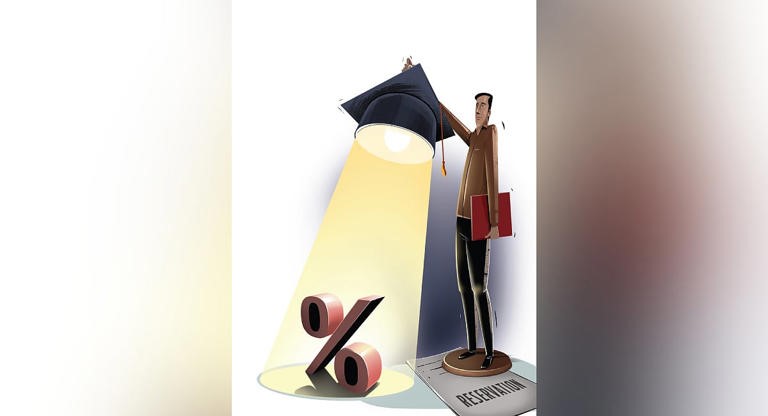Reservation in Private Universities: A Delayed Social Justice Reform
Syllabus:
GS-2:
Social Empowerment , Issues Related to SCs & STs , Government Policies & Interventions
Focus:
Recently, the Congress Party reiterated its longstanding demand for reservations in private educational institutions for SCs, STs, and OBCs. Although constitutionally permissible and legally upheld, this provision has seen little political follow-through. The issue gains relevance amid rising privatization of education and deepening social inequities in access.
The Case for Reservation in Private Higher Educational Institutions:
Constitutional and Legal Background
- The 93rd Constitutional Amendment Act (2005) empowered the state to make special provisions for socially and educationally backward classes (SEBCs), SCs, and STs in private educational institutions, excluding minority-run ones.
- The Supreme Court in Ashoka Kumar Thakur (2008) upheld the legality of reservations in state-aided and unaided institutions.
- The 2011 and 2013 rulings further cemented the legal validity of reservation in unaided private institutions, removing doubts over constitutional permissibility.
Current Policy Gap
- Despite the legal foundation, private universities and deemed-to-be universities have largely remained outside the purview of reservation norms.
- Public institutions are mandated to follow reservation policies, but private players operate with de facto reservation for the privileged (i.e., the rich and upper-caste students).
- This results in a parallel education system—one inclusive and underfunded, the other elite, well-resourced, and exclusionary.
Changing Landscape of Higher Education in India:
Mass Expansion in Demand
- Over the last few decades, there has been a dramatic increase in the demand for higher education among marginalized groups:
- Between 1960–61 and 2018–19, the number of universities rose almost tenfold.
- Gross Enrolment Ratio (GER) has risen nearly 2.5 times.
- SCs, STs, OBCs, Muslims, and women have all shown substantial increases in enrollment, reflecting a growing aspiration for upward mobility through education.
Privatization of Supply
- Parallel to this demand, there’s been a massive growth in private higher education institutions (PHEIs):
- From 2015 to 2024, private universities (including deemed) grew from 276 to 523.
- In 2021–22, private universities accounted for 26% of total universities.
- Private unaided colleges made up 45% of undergraduate enrollments.
- This expansion is highly skewed in favor of the elite, leading to two-tier educational access.
Unequal Social Profile in Private Institutions:
Disproportionate Representation
- According to the All India Survey on Higher Education (AISHE) 2021–22:
- Upper-caste Hindus (20% of the population) account for over 60% of students in private universities.
- SCs: Just 6.8% in private universities (population share: ~17%)
- STs: 3.6% (population share: ~9%)
- OBCs: 24.9% (population share: 45–50%)
- Muslims: 3.8% (population share: ~15%)
- In contrast, public universities (which follow reservation norms) show a much more balanced profile:
- SCs: 14.6%
- STs: 6%
- OBCs: 31.2%
- Muslims: 4.1% (not covered under reservation)
Social Implications
- The elite capture of private institutions preserves social distance and worsens inequalities.
- Students from marginalized backgrounds are pushed to underfunded public institutions or forced out of the higher education system entirely.
Policy Inaction and the Need for Political Will:
Absence from National Education Policy (NEP)
- The NEP 2020, despite being hailed as transformative, makes no mention of reservation in private institutions.
- The broader policy trend has leaned towards privatization and commercialization of education without corresponding social safeguards.
Missed Opportunities for Reform
- The Congress Party had included reservation in private education as part of its 2024 manifesto and reiterated the demand recently.
- A parliamentary committee backed this idea.
- Yet, no concrete policy action has followed.
- Without political will, constitutional promises remain dead letters.
The Way Forward: Towards Inclusive Higher Education
Dual Strategy Needed
- Strengthening public higher education:
- Increase funding and improve infrastructure.
- Fill faculty vacancies and ensure academic autonomy.
- Support professional development and skilling programs.
- Regulating private institutions:
- Mandate reservation policies for SCs, STs, and OBCs.
- Encourage scholarships and fee waivers for underprivileged students.
- Monitor social representation and enforce accountability.
Bridging the Justice Gap
- Legal mechanisms exist, and constitutional backing is solid.
- What’s lacking is decisive political action to ensure that the expansion of private education does not come at the cost of social justice.
- Bringing social justice parties like DMK, RJD, and others on board could help build a coalition for reform.
Conclusion:
Reservation in private higher education is not merely a policy choice but a constitutional imperative. Without it, marginalized communities are excluded from quality education as private institutions dominate the higher education landscape. Ensuring social justice requires strong political will, legal enforcement, and a genuine commitment to inclusive development.
Source: IE
Mains Practice Question :
Despite constitutional and legal sanction, reservations are largely absent in private higher education institutions in India. Discuss the implications of this exclusion for social justice and suggest policy measures to bridge this gap in the context of the expanding role of private players in the education sector.




